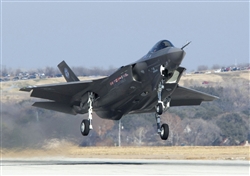The suspension of flight operations for the F35-B, the Marine Corps version of the Joint Strike Fighter, is sure to provoke more criticism of the F-35 program. But rushing to scale back the program is exactly the wrong way to make effective investment decisions.
A defense acquisitions plan that promotes the long-term national security interests of the United States requires strategic, unbiased thinking about the security challenges we face and the best capabilities to address those challenges.
The JSF program is the perfect example of the need for a strategic approach to defense acquisitions. High-tech and super stealthy, the F-35 is designed to replace a wide range of aircraft, making it the plane of the future for the Air Force, Navy, and Marine Corps.
The F-35 has had schedule delays and cost overruns, for which there are a number of causes. Chief among them is concurrency, the practice of moving forward with production before development and testing is complete. As a result, new planes may roll off the assembly line already in need of significant retrofitting – an unintended consequence of the plan to field the aircraft quickly and efficiently.
For many, the solution to the F-35’s rising costs and technical setbacks is to cut back or even cancel the program. This is the kind of knee-jerk reaction we must avoid. We must weigh consequences, costs, and alternative solutions, all in the light of strategic requirements rather than jumping to conclusions.
Buying fewer F-35s is a tempting solution to the affordability. But reducing the buy creates problems too. Buying fewer aircraft means each one costs more. And the more each plane costs, the more risky it becomes to use them.
The B-2 bomber, developed and produced in the 1980s, is the textbook case of poor management. Attempting to cut costs, planners reduced the buy from 132 to 21, driving up the unit price to $2 billion per copy. The result was a bomber that the military was reluctant to use. “If it does badly, and it crashes, you’d have a $2 billion smoking hole in the desert, which could be a bit embarrassing,” one Air Force official explained.
Our goal today is to solve the F-35 dilemma while avoiding another B-2 fiasco. This will require answering some tough questions.
For example, one frequently cited option is to buy more F-16s or F/A-18s instead of the F-35. This would mean losing the F-35’s formidable stealth capabilities. and this is clearly and important capability for future operations,
Restarting the F-16 production line could also entail significant costs. How do those costs stack up compared to the F-35? Similarly, the F-35 has been criticized for high operating costs over the lifetime of the program. But how much will it cost to operate F-16s over the same time frame? Is the short-term gain in lower procurement costs worth the long-term loss in capability?
Other options to reduce costs would be to strip some of the higher-end capabilities, relying more on off-the-shelf-technology, or to slow down production, allowing time for more testing and troubleshooting. These options entail both benefits and costs; they should be carefully weighed as we consider the best path forward for the F-35.
As the largest program in procurement history, the F-35 is bound to generate some sensational media headlines. But allowing each setback or success to impact the overall plan would be a mistake. We need a stable, long-term procurement plan for the JSF, and strategic analysis is the only way to get there.



